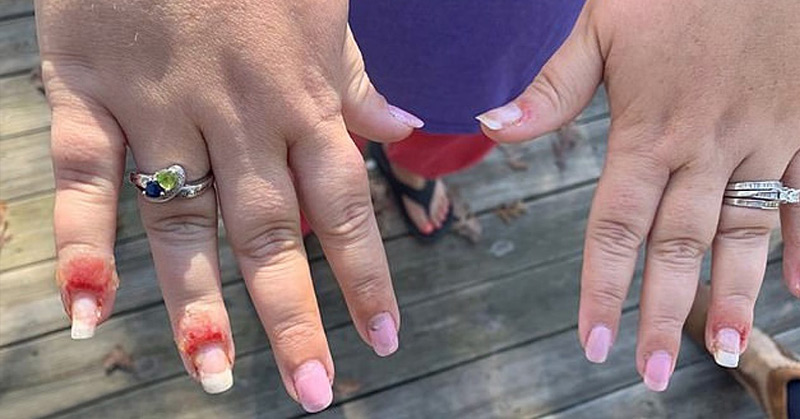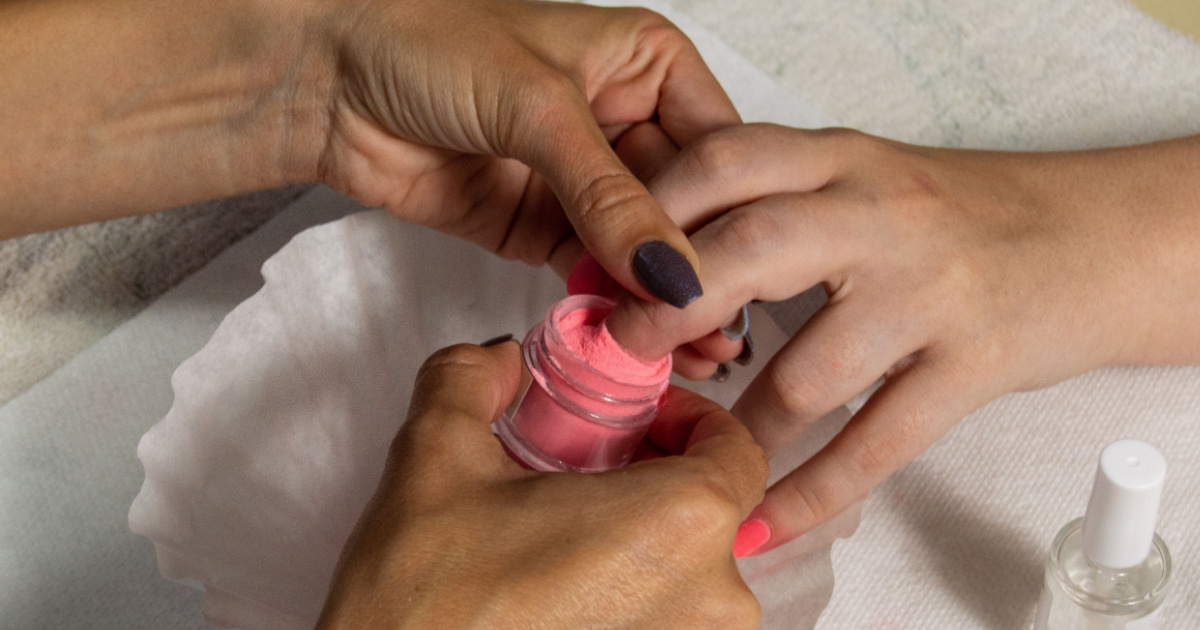Editor’s note: this article has been updated to include information about another possible risk factor associated with dip powder manicures: Herpes Whitlow. The woman in the article did not contract the virus, but it is another important risk to be aware of should you decide to visit a nail salon.
This article was originally published in December 2019 and has since been updated.
Millions of people visit nail salons across America every year [1]. Some make it a regular habit, some in preparation for a big event or a trip. And while the vast majority of these visits result in nothing more than a more polished set of nails, they can take a turn for the worse if you’re not careful.
A North Carolina woman learned this the hard way after a visit to her local nail salon on October 17, 2019. Bethany, who requested her last name not be published, received what is called a “dip powder manicure” at a salon near her home in Greensboro, North Carolina, and was left days later with swollen and bleeding nail beds that were oozing puss [2].
After a visit with her doctor, she was told that she had contracted a fungal infection, likely from dipping her nails into the same powder that had been used for previous customers [2].
What is a dip powder manicure?
Most dip powders combine a glue-type liquid and powder that hardens when exposed to air. You simply dip your nails into the colored powder that you want and seal it with a topcoat. The process is repeated multiple times until the polish has hardened. The benefits of this type of manicure are that it is long-lasting (the polish will stay on for up to two or four weeks), it doesn’t require any ultraviolet light to cure or dry it, and there isn’t the pungent odor associated with other manicure techniques [3].
Many salons, however, will not offer this treatment due to sanitation concerns.
“It is incredibly unsanitary for multiple clients to dip their fingers in the same container of powder, even pouring the product over multiple clients’ nails and allowing the product powder to fall back into the container is an easy way for nail infections to be passed between clients,” says licensed nail technician Harli G [3].
How safe are nail salons?
While serious infections are rare, they can happen.
“[Clients can contract] anything from a bacterial infection to a fungal infection and also viral infections,” explained the AHS medical officer of health. “Whether that would be warts or blood-borne viruses such as HIV, hepatitis B or hepatitis C.” [4]
The biggest risk comes from improperly disinfected tools coupled with small abrasions or open wounds that can occur during the manicure or pedicure process. Even recently waxed or shaved legs can allow microorganisms to enter through the skin [5].
Unfortunately, despite the popularity of nail salons across the United States (there are over 54 thousand throughout the country [6]), there is an alarming lack of consistency with regards to sanitary requirements within the salons [7]. This, coupled with insufficient education and training for salon workers leaves customers vulnerable to infections.
In Bethany’s case, it was a small cut to one of her fingers during the manicure that lead to her infection [2].

Herpes Whitlow
In addition to fungal, bacterial, and other viruses, one particular ailment of concern is Herpetic whitlow, or herpes whitlow. It is a painful cutaneous infection created by the herpes simplex virus (HSV) that produces a wound on the finger called a whitlow [8,9].
“Instead of manifesting on the mouth, like you would think of like a cold sore,” explained Dr. Lourdes Norman-McKay, a microbiologist with the Florida State College of Jacksonville. “It’s manifesting on the fingers.” [10]
Norman-McKay explained that you can catch the virus if you have an open wound on your finger, or spread it to someone else. Once you have it, though, you have it for life.
“Herpes Whitlow is very obvious, with these really dramatic oozing lesions that anyone should say, ‘We’re not going to do your nails.’ But we do know that they still will do nails in many cases, because they don’t know necessarily what they’re looking at,” Norman-McKay said. “So even if a nail technician may notice that someone has some fungal infection on their nails, or maybe a little lesion, they’re not real likely to turn away business.” [10]
What to watch out for at Nail Salons
This is not to say that you should never go to a nail salon. They can be enjoyable, relaxing and safe experiences, however, there are some steps you can take to avoid the same fate as Bethany.
- If you have an open wound or even a scab on your hands or your feet, postpone your appointment until it heals [4].
- Find out from your nail technician where he or she was trained – reputable colleges teach proper sanitation practices [4].
- Pay attention to what type of tools are being used and how they are stored. They should be stainless steel and kept in sealed packages or soaked in jars of hospital-grade disinfectant [4]. Don’t be afraid to ask to see their cleaning log, or to show you their disinfecting process.
- The technician should always be wearing gloves. If they aren’t – ask them to [11].
- Check the floors – if they look really dirty (think scattered fingernail clippings) there’s a good chance their equipment is not being cleaned the way it should be either [11].
- On that note, check the bathroom. If it isn’t clean, neither is the rest of the salon [11].
- You shouldn’t be in pain – if the technician is being too aggressive, ask them to ease up [11].
- Never shave before going to the salon. Shaving opens up the tiny pores on your skin and leaves you vulnerable to infection [11].
- Never put your feet in potentially dirty water – ask that the basin be filled in front of you, and if you can avoid jetted tubs since they are harder to clean [4].
DIY Nail Solutions
The best way to avoid contracting an infection at a salon, of course, is to avoid nail salons altogether. This does not mean, however, that you can’t bring the spa to you. There are many ways to get that salon-quality manicure you desire in the comfort (and cleanliness) of your own home. As an added bonus, giving yourself a manicure at home is less expensive, so you can put those savings toward that tropical vacation you’re planning to show off your perfectly-polished toes.
Goodhousekeeping.com has put together a list of some of the best at-home dip powder manicure kits[12] and wikihow.com offers a step-by-step guide on how to give yourself the treatment [13].
If you’re feeling very crafty, you can even make your own nail polish with olive oil, ginger root powder, beeswax, vitamin E oil, and jojoba oil.
Take your health into your own hands
Whether you decide to go to the salon or try a DIY at-home manicure, always remember that you are responsible for your health and safety. Ask questions, do your research, and if you don’t feel comfortable with where you are, you can always leave.
Keep Reading: ‘I Thought I Had A Headache. It Turned Out To Be Herpes (HSV-1) — In My Brain.’
Sources
- “U.S. population: Frequency of manicures within 6 months from 2011 to 2020.” Statista
- “North Carolina woman says she was left with a fungal infection and bloody, swollen fingers after popular dip powder manicure.” Daily Mail. Mary Kekatos. November 15, 2019.
- “Woman posts ‘dip powder’ manicure warning: Here’s what you need to know.” Good Morning America. Jacqueline Laurean Yates. August 1, 2019.
- “Nail salon safety: What to watch for at your next manicure or pedicure.” Global News. Su-Ling Goh. September 4, 2017.
- “Manicure & Pedicure Safety: How Safe is Your Nail Salon?” Clean My Space
- “Number of nail salons in the United States from 2006 to 2018*.” Statista
- “Risk for Hepatitis B and C Virus Transmission in Nail Salons and Barbershops and State Regulatory Requirements to Prevent Such Transmission in the United States.” Journals. Yang, Jun PhD, MS, et al. December 2014.
- “What to know about herpetic whitlow.” Medical News Today. Jon Johnson. May 12, 2023.
- “Herpetic Whitlow.” Merck Manuals. David R. Steinberg ,MD, Perelman School of Medicine at the University of Pennsylvania. April 2022.
- “Dip powder manicures could be putting your health at risk.” Action News Jax. Alicia Tarancon. February 14, 2020.
- “Nail Salon Know-How: 9 Things to Know Before Your Next Manicure.” ABC News. March 7, 2014
- “10 Best Dip Powder Nail Kits for a Salon-Quality Manicure at Home.” Good Housekeeping. Dori Price. May 8, 2023.
- “How to Do a Dip Powder Manicure.” Wiki How. March 24, 2023.
Disclaimer: This information is not intended to be a substitute for professional medical advice, diagnosis or treatment and is for information only. Always seek the advice of your physician or another qualified health provider with any questions about your medical condition and/or current medication. Do not disregard professional medical advice or delay seeking advice or treatment because of something you have read here.

